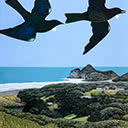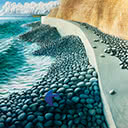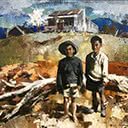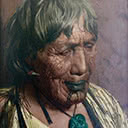Sea Wall and Kingfisher, 1967
110 x 122 cm
est. $250,000 - 350,000
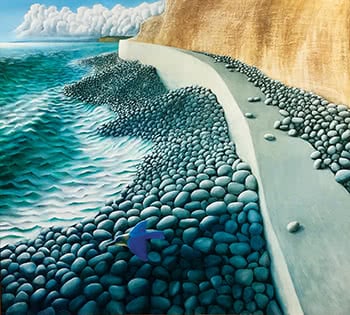 Relative size
Relative size
PROVENANCE
Purchased at Peter McLeavey Gallery, 1969
by current owners parents
Collection of Michael & Brigid Chunn,
ILLUSTRATED
p. 85 Michael Smither Painter,
Trish Gribben, Ron Sang Publications, 2004
Seawall and Kingfisher, 1967 is a sweeping encounter between land, sea and sky. Acquired from Peter McLeavey Gallery in 1967 by the current owners family, this is one of the most important paintings by Michael Smither to have been presented to the market.
The concrete seawall which bisects the cliff face and sea was built to protect the Taranaki coastline, and to prevent the erosion of Kawaroa Park. The title draws our attention to the wall, suggesting that this scene is at least partly a reflection on the land's degeneration, and commenting on the need for man made intervention.
The presence of a beautiful gliding kotare in this painting is particularly special because the bird's inclusion is a tip of the hat to Smither's contemporary, Don Binney. These two artists had much in common, particularly during this 1960s period of production when their respective hard-edged, realist styles were shaping an emergent language of New Zealand modernism. Their work also shares thematic concerns around conservation and protection of the environment.
Rocks along the Taranaki coastline, were a common motif in Michael's Smither's work throughout the 1960s, and one which he returned to decades later in his career. In this painting, the luminous arrangement of rocks along the waterfront is as recognisable to Smither's hand as soaring birds are to Binney's. They are carefully stacked onto each other. Each rock is smoothly formed, with a sense of clarity and selfcontained coolness.
To the viewer, they may seem almost too perfect to be able to connect with physically, as if they exist in a slightly surreal, other-worldly space. One of the striking things about this painting is how the different natural elements appear in exchange with each other. Smither has sculpted the rocks against the seawall, with each of the individual forms existing as part of a larger whole. He has talked about the points of contact that maintained the balance of rock on rock, and it is this sense of integral balance and unity which commands our focus as viewers, and seems to run between the different natural elements in the work. Alongside the rippling waves, and smoothness of the seawall, the rocks' texture and form is exaggerated.
In the title of another of his rock series works, Smither describes the land as suckling the sea, which also feels relevant to this painting. Here, the sea is presented as a life force. Imagine that every rock in this picture has its perfect opposite in the fluid form of the sea, in the colour reflected back from the hardness of form onto an ever-changing, lapping tide. Then, the lines of this work become even more pronounced, with each ripple seemingly connecting to the land.
In addition to these visual rhythms, there is strong symbolism within this work - in the oneness of land and sea, and the spiritual, purifying qualities of water. It may be considered baptismal; speaking to the promise of new life. Finally, there is the kingfisher, the only living creature in the scene and a bearer of good fortune. Its presence is a symbol of abundance, prosperity, and hope for the land.

